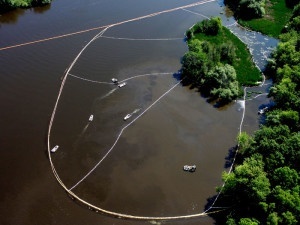We have much more to do and your continued support is needed now more than ever.
Enbridge’s Nose Grows a lot Longer

The large problem for Enbridge is that they can’t hide from the real-life facts. Enbridge has the best (and worst) “study” right here in the Kalamazoo River, where they spilled around a million gallons of tar sands crude into Michigan waters. This spill has proven the exact opposite: tar sands oil sinks in fresh water!
This is not a little white lie: the fact that tar sands oil sinks in water is one of the biggest problems facing the industry and pipeline operators, proving that any spill of any kind into water is devastating, toxic and impossible to clean-up. The hundreds of acres of submerged oil in the Kalamazoo River — that Enbridge can’t clean up — is case and point!
Steep Learning Curve for Tar Sands Spills
Michigan journalist Fritz Klug wrote about this very point almost two years ago:
“At minimum, we’re writing a chapter in the oil spill cleanup book on how to identify submerged oil,” [EPA incident commander Ralph] Dollhopf said. “We’re writing chapters on how it behaves once it does spill (and) how to recover it.”
What the EPA didn’t expect at the beginning of the spill last July was how much time they would spend extracting the heavier oil submerged in the bottom of the Kalamazoo River.
“In a situation where we don’t have to be concerned with submerged oil, then we clean up the oil on the surface and be done,” Dollhopf said.
This past fall, the EPA issued Enbridge another work order to address the hundreds of acres of submerged oil, but Enbridge is dismissing that order because they have no idea how to remove the oil from the bottom of the river without causing extreme habitat destruction.
When a tar sands pipeline spill occurs, all readily available equipment used to clean-up oil will only address oil floating on the surface of water. So, for any pipeline operator to say they know how to properly clean up tar sands crude — this is a flat out lie.
Again, this point is extremely important considering the flood of tar sands pipeline projects hitting the U.S.

Lawmakers in the Dark
Taking this a step further, the lack of acknowledgment by our decision makers and congressional members is a little shocking. Our leaders should be demanding that regulators and pipeline operators make immediate changes to spill response plans to address this very issue, and no tar sands pipelines should be expanded or constructed until issues like this are fully addressed. This should have been an outcry immediately following Enbridge’s spill — especially considering tar sands crude is already running through many pipelines that travel in and around the Great Lakes, which are the freshwater drinking source for millions or people and habitat for countless wildlife.
In fact, many members of Congress are ignoring the facts and trying to streamline massive tar sands pipeline projects, like Keystone XL, which will expose millions to the risk of spills and drive development in Canada’s tar sands region, one of the biggest threats to our global climate.
We are allowing Enbridge to cover up the facts with propaganda, which will continue to allow the industry to expand plans for transporting tar sands oil through some of the most sensitive areas in the world.
![]() Contact your lawmakers and tell them you are sick of industry distorting the facts, which continues to put our communities, resources and wildlife at risk.
Contact your lawmakers and tell them you are sick of industry distorting the facts, which continues to put our communities, resources and wildlife at risk.





















